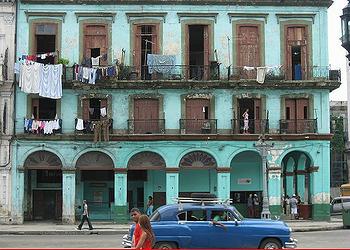
By Calixto Ramón Martínez Arias
HAVANA, Cuba, October 3, 2012 (ENS) – Poor maintenance of drains at an apartment block in central Havana has created a serious health hazard for residents. A maintenance worker says much of the Cuban capital is affected by blocked sewage systems.
Blocked drains at 668 San Martín Road have flooded the sewage tank, polluting the cistern which stores water for drinking, cooking and bathing.
“When a visitor comes to my home, I feel so embarrassed by the stench they’re forced to breathe in. No one can stand it,” said a woman who lives on the ground floor of the apartment block, where the hallway is flooded with foul-smelling water.

Other residents say the blocked pipes mean they have to collect their feces in plastic bags and throw them out with the rubbish.
Doctors who have inspected conditions in the building say the 36 people who live there are at risk of cholera, dengue fever and other illnesses. At least two children have been treated for infectious diseases in recent weeks.
Yamilet López Montesino took her 13-year-old daughter to hospital after she fell ill. Medical staff asked about sanitary conditions at her home, and sent a team along to investigate.
“A doctor arrived with people from the Anti-Aegypti [mosquito] Campaign,” she said. “On seeing the state of the building, they said they would notify the state-run Sewage Management Company, which is in charge of repairing and maintaining sewage systems.”
Another doctor who visited the building said, “When drainage water contaminates the cistern, it exposes people to cholera and hepatitis A – illnesses which, along with dengue fever are hitting this country hard.”
“Hepatitis A is a mild illness, but if it isn’t attended to properly it can become dangerous, Meanwhile, cholera, dengue, leptospirosis and salmonella can be deadly,” the doctor warned, adding that he had observed rat, mosquito, and cockroach infestations in the building.
Dengue fever, now common in parts of Latin America including Cuba, is spread by the yellow fever mosquito, Aedes aegypti. In August, the Inter Press Service news agency quoted the Cuban health ministry as saying mosquito infestation had reached “critical” level in 23 municipalities across the country. Leptospirosis or Weil’s syndrome is transmitted from animals to humans.
People living in the area say sewage has been a problem at the apartment block for some years now.
“This isn’t the first time that we’ve been in this position,” said Yureisy Masa Negreg, whose two–year-old-son has been suffering from fever, vomiting and diarrhea. “But it’s been nearly two months now. We have filed complaints with all the government institutions, yet no one is fixing the problem.”

An employee of the Sewage Management Company in the city said he is aware of the issues, but there was little he can do as the blockage is in the sewage mains pipe rather than inside the building.
“We do repairs from the entrance to the interior, while others are responsible for repairs [under] the street. In this building, the flooding is due to a blockage in the [mains ] pipe,” he said.
He said similar blockages in drainage pipes now affect more than 60 percent of Havana residents.
“These sewage systems are very old. Many of them have gone 50 years or more without having the necessary maintenance done,” he said. “The government is making a big effort but it’s very expensive, and the economic situation means we can’t afford it. Don’t forget that we’re a country under blockade.”
Residents of the apartment block point out that things can be fixed when there is a will to do so.
A burst drain at a shop just 25 meters away was fixed in under 24 hours. The shop, called La Mía, is state-run but rather up-market as it only accepts convertible currency, not normal Cuban pesos.
Meanwhile, residents of the San Martín Road block have developed a rota for washing since their own bathroom facilities are out of order.
“We have to bathe in the hallway. We use buckets to collect the water, and then throw it into the road,” López said. “The men and children go first, and we women have to wait until late at night. It isn’t easy. When I finish work, I have no wish to come back here.”
{This article was written by Hablemo Press reporter Calixto Ramón Martínez Arias before his arrest on September 16. He is to be charged with being disrespectful towards President Raúl Castro and his brother Fidel Castro. The article was first published by the Institute for War and Peace Reporting.}
{Editor’s Note: In May 2012, the Kuwait Fund for Arab Economic Development signed several agreements with the Cuban government to finance a project for the rehabilitation of the Havana water and sewer system, the Prensa Latina news agency reported. Under the agreement, 70,000 meters of piping, control valves and accessories will be supplied and installed for residential service, while about 130 miles of the water supply network and 300 miles of the sewer system will be rehabilitated.}
Copyright Environment News Service (ENS) 2012. All rights reserved.
